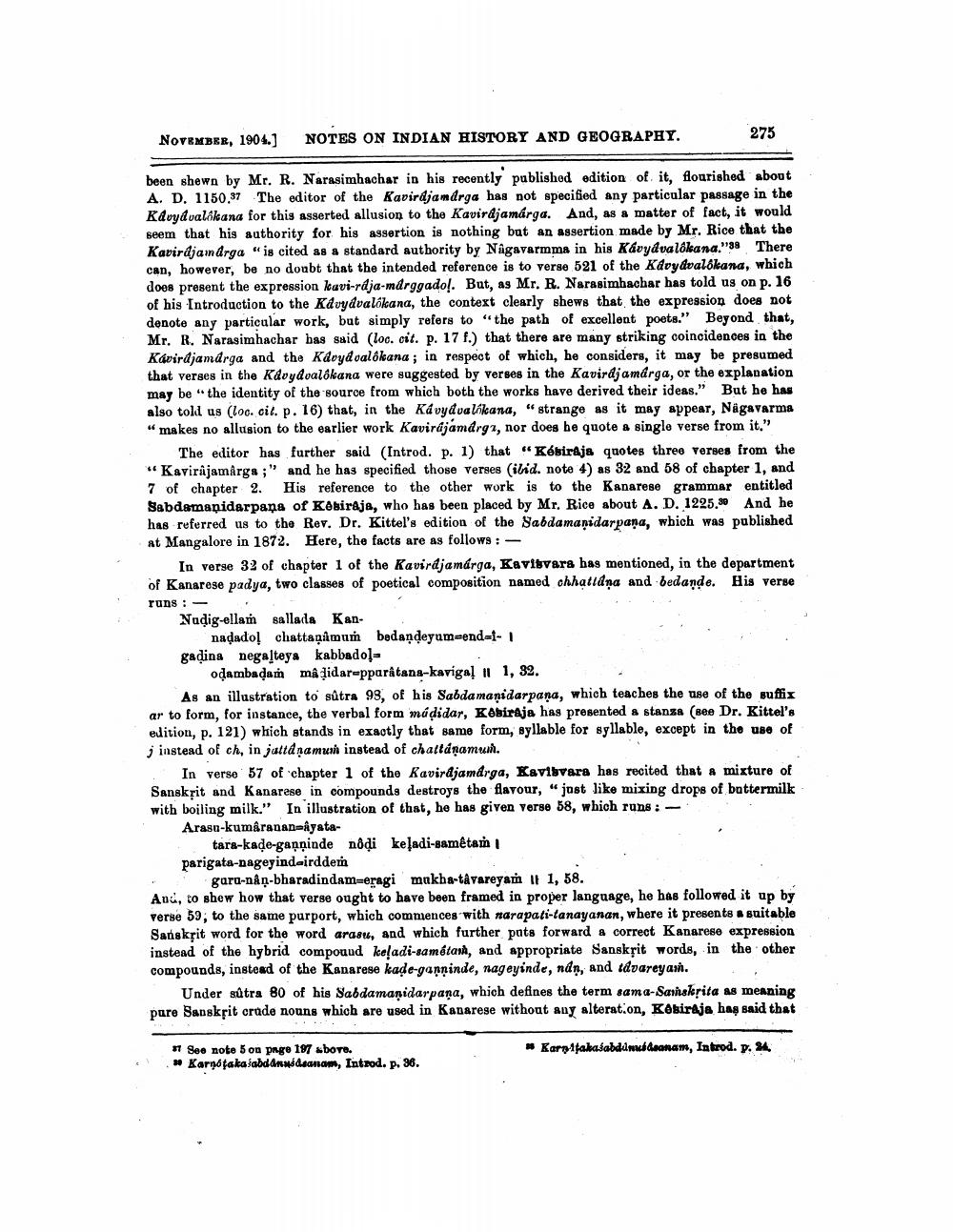________________
NOVEMBER, 1904.)
NOTES ON INDIAN HISTORY AND GEOGRAPHY.
275
been shewn by Mr. R. Narasimhachar in his recently published edition of it, flourished about A. D. 1150.37 The editor of the Kavirdjandrga has not specified any particular passage in the Kdvydvalókana for this asserted allusion to the Kavirajamárga. And, as a matter of fact, it would seem that his authority for his assertion is nothing but an assertion made by Mr. Rice that the Kavirdjandrga “is cited as a standard authority by Nagavarmma in his Kávydvalókana."88 There can, however, be no doubt that the intended reference is to verse 521 of the Kdvydvalókana, which does present the expression kavi-rdja-mdrggado!. But, as Mr. R. Narasimhachar has told us on p. 16 of his Introduction to the Kdvydvalókana, the context clearly shews that the expression does not denote any particular work, but simply refers to “the path of excellent poets." Beyond that, Mr. R. Narasimhachar bas said (loc. cit. p. 17 f.) that there are many striking coincidences in the Kavirajamarga and the Kdoyd valókana ; in respect of which, be considers, it may be presumed that verses in the Kdoydvalókana were suggested by verses in the Kavirdjamárga, or the explanation may be the identity of the source from which both the works have derived their ideas." But he has also told us (loc. cit. p. 16) that, in the Kávydvalókana, “strange as it may appear, Nagavarma "makes no allusion to the earlier work Kavirajamdrg2, nor does be quote a single verse from it."
The editor has further said (Introd. p. 1) that “Kókirajs quotes threo verses from the "Kavirajamarga ;' and he has specified those verses (ibid. note 4) as 32 and 58 of chapter 1, and 7 of chapter 2. His reference to the other work is to the Kanarese grammar entitled Sabdamanidarpana of Kobiraja, who has been placed by Mr. Rice about A. D. 1225.30 And he has referred us to the Rev. Dr. Kittel's edition of the Sabdamanidarpana, which was published at Mangalore in 1872. Here, the facts are as follows:
In verse 33 of chapter 1 of the Kavirdjamárga, Kavisvara has mentioned, in the department of Kanarese padya, two classes of poetical composition named chhattdna and bedande. His verse runs : Nudig-ella sallada Kan
nadado! chattanimum bedandeyum-end-1-1 gadina negalteya kabbadola
odambadarn mâ lidar-pparâtana-kaviga! 111, 32. As an illustration to søtra 99, of his Sabda manidarpana, which teaches the use of the suffix ar to form, for instance, the verbal form mádidar, Kebiraja has presented a stanza (see Dr. Kittel's edition, p. 121) which stands in exactly that same form, syllable for syllable, except in the use of instead of ch, in jaitd namun instead of challdņamu.
In verse 57 of chapter 1 of the Kavirajamdrga, Kavibvara has recited that a mixture of Sanskrit and Kanarese in compounds destroys the flavour, just like mixing drops of buttermilk with boiling milk." In illustration of that, he has given Vorso 58, which runs: - Araso-kumaranan-âyata
tara-kade-ganninde nödi keladi-samêtam parigata-nageyindeirddem
gara-nan-bharadindam-eragi mukha-távareyam | 1, 58. And, to shew how that verse ought to have been framed in proper language, he has followed it up by Verse 59, to the same purport, which commences with narapati-tanayanan, where it presents a suitable Sanskțit word for the word arası, and which further pats forward a correct Kanarese expression instead of the hybrid compound keladi-samétas, and appropriate Sanskrit words, in the other compounds, instead of the Kanarese kade-garninde, nageyinde, ndn, and tdvareyas.
Under sútra 80 of his Sabdamanidarpana, which defines the term sama-Sarnskrita as meaning pure Sanskrit crude nouns which are used in Kanarese without any alteration, Kobiraja haş said that
11 See note 5 on page 199 &bore. # Karno takaabdan wideanam, Introd. p. 36.
Karnitakasabdurub deanam, Introd. p. 24




